Effects of Astronomical Cycles on Laminated Shales of the Paleogene Shahejie Formation in the Dongying Sag, Bohai Bay Basin, China
Abstract
1. Introduction
2. Geological Setting
3. Data and Methods
3.1. Gamma Ray Well Log Data
3.2. Time Series Methods
3.3. Grayscale Data
4. Results
4.1. Mineralogy
4.2. Time Series Analysis
5. Discussion
5.1. Multi-Scale Cyclicity and Astronomical Constraint Interpretation
5.1.1. Hundred-Meter Scale Cyclicity
5.1.2. Ten-Meter Scale Cyclicity
5.1.3. Meter-Scale Cyclicity
5.2. A Model of Astronomically Constrained Shale Cyclicity
5.3. Implications for Continental Shale Oil Exploration and Development

6. Conclusions
Author Contributions
Funding
Data Availability Statement
Conflicts of Interest
References
- Eldrett, J.S.; Ma, C.; Bergman, S.C.; Ozkan, A.; Minisini, D.; Lutz, B.; Jackett, S.-J.; Macaulay, C.; Kelly, A.E. Origin of limestone–marlstone cycles: Astronomic forcing of organic-rich sedimentary rocks from the Cenomanian to early Coniacian of the Cretaceous Western Interior Seaway, USA. Earth Planet. Sci. Lett. 2015, 423, 98–113. [Google Scholar] [CrossRef]
- Jaminski, J.; Algeo, T.J.; Maynard, J.B.; Hower, J.C. Climatic origin of dm-scale compositional cyclicity in the Cleveland Member of the Ohio Shale (Upper Devonian), Central Appalachian Basin, USA. Shales Mudstones 1998, 1, 217–242. [Google Scholar]
- Zhang, J.; Jiang, Z.; Liang, C.; Baars, T.F.; Wang, Y.; Abels, H.A. Astronomical forcing of meter-scale organic-rich mudstone–limestone cyclicity in the Eocene Dongying sag, China: Implications for shale reservoir exploration. AAPG Bull. 2022, 106, 1557–1579. [Google Scholar] [CrossRef]
- Kietzmann, D.A.; Palma, R.M.; Llanos, M.P.I. Cyclostratigraphy of an orbitally-driven Tithonian–Valanginian carbonate ramp succession, Southern Mendoza, Argentina: Implications for the Jurassic–Cretaceous boundary in the Neuquén Basin. Sediment. Geol. 2015, 315, 29–46. [Google Scholar] [CrossRef]
- Michalzik, D. Lithofacies, diagenetic spectra and sedimentary cycles of Messinian (Late Miocene) evaporites in SE Spain. Sediment. Geol. 1996, 106, 203–222. [Google Scholar] [CrossRef]
- Westphal, H.; Munnecke, A. Limestone-marl alternations: A warm-water phenomenon? Geology 2003, 31, 263–266. [Google Scholar] [CrossRef]
- Li, Q.; Xu, S.; Hao, F.; Shu, Z.; Chen, F.; Lu, Y.; Wu, S.; Zhang, L. Geochemical characteristics and organic matter accumulation of argillaceous dolomite in a saline lacustrine basin: A case study from the paleogene xingouzui formation, Jianghan Basin, China. Mar. Pet. Geol. 2021, 128, 105041. [Google Scholar] [CrossRef]
- Lu, Y.; Jiang, S.; Lu, Y.; Xu, S.; Shu, Y.; Wang, Y. Productivity or preservation? The factors controlling the organic matter accumulation in the late Katian through Hirnantian Wufeng organic-rich shale, South China. Mar. Pet. Geol. 2019, 109, 22–35. [Google Scholar] [CrossRef]
- Schieber, J.; Southard, J.; Thaisen, K. Accretion of mudstone beds from migrating floccule ripples. Science 2007, 318, 1760–1763. [Google Scholar] [CrossRef]
- Chen, L.; Lu, Y.; Jiang, S.; Li, J.; Guo, T.; Luo, C. Heterogeneity of the Lower Silurian Longmaxi marine shale in the southeast Sichuan Basin of China. Mar. Pet. Geol. 2015, 65, 232–246. [Google Scholar] [CrossRef]
- Hao, F.; Zhou, X.; Zhu, Y.; Yang, Y. Lacustrine source rock deposition in response to co-evolution of environments and organisms controlled by tectonic subsidence and climate, Bohai Bay Basin, China. Org. Geochem. 2011, 42, 323–339. [Google Scholar] [CrossRef]
- Lourens, L.J.; Antonarakou, A.; Hilgen, F.; Van Hoof, A.; Vergnaud-Grazzini, C.; Zachariasse, W. Evaluation of the Plio-Pleistocene astronomical timescale. Paleoceanography 1996, 11, 391–413. [Google Scholar] [CrossRef]
- Strasser, A.; Hilgen, F.J.; Heckel, P.H. Cyclostratigraphy—concepts, definitions, and applications. Newsl. Stratigr. 2006, 42, 75–114. [Google Scholar] [CrossRef]
- Hays, J.D.; Imbrie, J.; Shackleton, N.J. Variations in the Earth’s Orbit: Pacemaker of the Ice Ages: For 500,000 years, major climatic changes have followed variations in obliquity and precession. Science 1976, 194, 1121–1132. [Google Scholar] [CrossRef]
- Palike, H.; Norris, R.D.; Herrle, J.O.; Wilson, P.A.; Coxall, H.K.; Lear, C.H.; Shackleton, N.J.; Tripati, A.K.; Wade, B.S. The heartbeat of the Oligocene climate system. Science 2006, 314, 1894–1898. [Google Scholar] [CrossRef]
- Wu, H.; Zhang, S.; Hinnov, L.A.; Jiang, G.; Yang, T.; Li, H.; Wan, X.; Wang, C. Cyclostratigraphy and orbital tuning of the terrestrial upper Santonian–Lower Danian in Songliao Basin, northeastern China. Earth Planet. Sci. Lett. 2014, 407, 82–95. [Google Scholar] [CrossRef]
- Webber, A.J. High-resolution faunal gradient analysis and an assessment of the causes of meter-scale cyclicity in the type Cincinnatian Series (Upper Ordovician). Palaios 2002, 17, 545–555. [Google Scholar] [CrossRef]
- Feng, Y.; Li, S.; Lu, Y. Sequence stratigraphy and architectural variability in late Eocene lacustrine strata of the Dongying Depression, Bohai Bay Basin, eastern China. Sediment. Geol. 2013, 295, 1–26. [Google Scholar] [CrossRef]
- Hao, F.; Zhou, X.; Zhu, Y.; Zou, H.; Bao, X.; Kong, Q. Mechanisms of petroleum accumulation in the Bozhong sub-basin, Bohai Bay Basin, China, Part 1: Origin and occurrence of crude oils. Mar. Pet. Geol. 2009, 26, 1528–1542. [Google Scholar]
- Liu, H.; Zhang, S.; Song, G.; Xuejun, W.; Teng, J.; Wang, M.; Bao, Y.; Yao, S.; Wang, W.; Zhang, S. Effect of shale diagenesis on pores and storage capacity in the Paleogene Shahejie Formation, Dongying Depression, Bohai Bay Basin, east China. Mar. Pet. Geol. 2019, 103, 738–752. [Google Scholar] [CrossRef]
- Li, M.; Huang, C.; Ogg, J.; Zhang, Y.; Hinnov, L.; Wu, H.; Chen, Z.-Q.; Zou, Z. Paleoclimate proxies for cyclostratigraphy: Comparative analysis using a Lower Triassic marine section in South China. Earth-Sci. Rev. 2019, 189, 125–146. [Google Scholar] [CrossRef]
- Huang, C.; Hinnov, L. Astronomically forced climate evolution in a saline lake record of the middle Eocene to Oligocene, Jianghan Basin, China. Earth Planet. Sci. Lett. 2019, 528, 115846. [Google Scholar] [CrossRef]
- Cleveland, W.S. Robust locally weighted regression and smoothing scatterplots. J. Am. Stat. Assoc. 1979, 74, 829–836. [Google Scholar] [CrossRef]
- Thomson, D.J. Spectrum estimation and harmonic analysis. Proc. IEEE 1982, 70, 1055–1096. [Google Scholar] [CrossRef]
- Mann, M.E.; Lees, J.M. Robust estimation of background noise and signal detection in climatic time series. Clim. Chang. 1996, 33, 409–445. [Google Scholar] [CrossRef]
- Kodama, K.P.; Hinnov, L.A. Rock Magnetic Cyclostratigraphy; John Wiley & Sons: New York, NY, USA, 2014; Volume 5. [Google Scholar]
- Li, M.; Kump, L.R.; Hinnov, L.A.; Mann, M.E. Tracking variable sedimentation rates and astronomical forcing in Phanerozoic paleoclimate proxy series with evolutionary correlation coefficients and hypothesis testing. Earth Planet. Sci. Lett. 2018, 501, 165–179. [Google Scholar] [CrossRef]
- Laskar, J.; Robutel, P.; Joutel, F.; Gastineau, M.; Correia, A.; Levrard, B. A long-term numerical solution for the insolation quantities of the Earth. Astron. Astrophy. 2004, 428, 261–285. [Google Scholar] [CrossRef]
- Li, M.; Hinnov, L.; Kump, L. Acycle: Time-series analysis software for paleoclimate research and education. Comput. Geosci. 2019, 127, 12–22. [Google Scholar] [CrossRef]
- Yao, Y.; Xu, D.; Zhang, H.; Han, Y.; Zhang, S.; Yin, Z.; Li, B.; He, Q.; Bian, X. A brief introduction to the Cenozoic astrostratigraphic time scale for the Dongying Depression, Shandong. J. Stratigr. 2007, 31 (Suppl. 2), 423–429. [Google Scholar]
- Shi, J.; Jin, Z.; Liu, Q.; Huang, Z.; Hao, Y. Terrestrial sedimentary responses to astronomically forced climate changes during the Early Paleogene in the Bohai Bay Basin, eastern China. Palaeogeogr. Palaeoclimatol. Palaeoecol. 2018, 502, 1–12. [Google Scholar] [CrossRef]
- Liu, Z.; Huang, C.; Algeo, T.J.; Liu, H.; Hao, Y.; Du, X.; Lu, Y.; Chen, P.; Guo, L.; Peng, L. High-resolution astrochronological record for the Paleocene-Oligocene (66–23 Ma) from the rapidly subsiding Bohai Bay Basin, northeastern China. Palaeogeogr. Palaeoclimatol. Palaeoecol. 2018, 510, 78–92. [Google Scholar] [CrossRef]
- Garzanti, E.; Vermeesch, P.; Padoan, M.; Resentini, A.; Vezzoli, G.; Andò, S. Provenance of passive-margin sand (Southern Africa). J. Geol. 2014, 122, 17–42. [Google Scholar] [CrossRef]
- von Eynatten, H.; Barceló-Vidal, C.; Pawlowsky-Glahn, V. Modelling compositional change: The example of chemical weathering of granitoid rocks. Math. Geol. 2003, 35, 231–251. [Google Scholar] [CrossRef]
- Abels, H.A.; Aziz, H.A.; Krijgsman, W.; Smeets, S.J.; Hilgen, F.J. Long-period eccentricity control on sedimentary sequences in the continental Madrid Basin (middle Miocene, Spain). Earth Planet. Sci. Lett. 2010, 289, 220–231. [Google Scholar] [CrossRef]
- Fang, Q.; Wu, H.; Hinnov, L.A.; Jing, X.; Wang, X.; Yang, T.; Li, H.; Zhang, S. Astronomical cycles of Middle Permian Maokou Formation in South China and their implications for sequence stratigraphy and paleoclimate. Palaeogeogr. Palaeoclimatol. Palaeoecol. 2017, 474, 130–139. [Google Scholar] [CrossRef]
- Zachos, J.; Pagani, M.; Sloan, L.; Thomas, E.; Billups, K. Trends, rhythms, and aberrations in global climate 65 Ma to present. Science 2001, 292, 686–693. [Google Scholar] [CrossRef] [PubMed]
- Huang, C.; Hinnov, L.A. Evolution of an Eocene-Oligocene saline lake depositional system and its controlling factors, Jianghan Basin, China. J. Earth Sci. 2014, 25, 959–976. [Google Scholar] [CrossRef]
- Lirer, F.; Harzhauser, M.; Pelosi, N.; Piller, W.E.; Schmid, H.P.; Sprovieri, M. Astronomically forced teleconnection between Paratethyan and Mediterranean sediments during the Middle and Late Miocene. Palaeogeogr. Palaeoclimatol. Palaeoecol. 2009, 275, 1–13. [Google Scholar] [CrossRef]
- Berger, A. Milankovitch theory and climate. Rev. Geophys. 1988, 26, 624–657. [Google Scholar] [CrossRef]
- Gambacorta, G.; Menichetti, E.; Trincianti, E.; Torricelli, S. Orbital control on cyclical primary productivity and benthic anoxia: Astronomical tuning of the Telychian Stage (Early Silurian). Palaeogeogr. Palaeoclimatol. Palaeoecol. 2018, 495, 152–162. [Google Scholar] [CrossRef]
- Imbrie, J.; Berger, A.; Boyle, E.; Clemens, S.; Duffy, A.; Howard, W.; Kukla, G.; Kutzbach, J.; Martinson, D.; McIntyre, A. On the structure and origin of major glaciation cycles 2. The 100,000-year cycle. Paleoceanography 1993, 8, 699–735. [Google Scholar] [CrossRef]
- Hinnov, L.A. New perspectives on orbitally forced stratigraphy. Annu. Rev. Earth Planet. Sci. 2000, 28, 419–475. [Google Scholar] [CrossRef]
- Wang, P.; Wang, B.; Cheng, H.; Fasullo, J.; Guo, Z.; Kiefer, T.; Liu, Z. The global monsoon across timescales: Coherent variability of regional monsoons. Clim. Past 2014, 10, 2007–2052. [Google Scholar] [CrossRef]
- Ma, W.; Tian, J.; Li, Q.; Wang, P. Simulation of long eccentricity (400-kyr) cycle in ocean carbon reservoir during Miocene Climate Optimum: Weathering and nutrient response to orbital change. Geophys. Res. Lett. 2011, 38, 1–5. [Google Scholar] [CrossRef]
- Berger, A.; Loutre, M.-F.; Laskar, J. Stability of the astronomical frequencies over the Earth’s history for paleoclimate studies. Science 1992, 255, 560–566. [Google Scholar] [CrossRef]
- Spicer, R.A.; Yang, J.; Herman, A.B.; Kodrul, T.; Maslova, N.; Spicer, T.E.; Aleksandrova, G.; Jin, J. Asian Eocene monsoons as revealed by leaf architectural signatures. Earth Planet. Sci. Lett. 2016, 449, 61–68. [Google Scholar] [CrossRef]
- Thomson, D.J. The seasons, global temperature, and precession. Science 1995, 268, 59–68. [Google Scholar] [CrossRef]
- Hinnov, L.A. Cyclostratigraphy and its revolutionizing applications in the earth and planetary sciences. GSA Bull. 2013, 125, 1703–1734. [Google Scholar] [CrossRef]
- Abels, H.A.; Abdul Aziz, H.; Calvo, J.P.; Tuenter, E. Shallow lacustrine carbonate microfacies document orbitally paced lake-level history in the Miocene Teruel Basin (North-East Spain). Sedimentology 2009, 56, 399–419. [Google Scholar] [CrossRef]
- Sierro, F.J.; Ledesma, S.; Flores, J.-A.; Torrescusa, S.; del Olmo, W.M. Sonic and gamma-ray astrochronology: Cycle to cycle calibration of Atlantic climatic records to Mediterranean sapropels and astronomical oscillations. Geology 2000, 28, 695–698. [Google Scholar] [CrossRef]
- Magri, D.; Tzedakis, P. Orbital signatures and long-term vegetation patterns in the Mediterranean. Quat. Int. 2000, 73, 69–78. [Google Scholar] [CrossRef]
- Li, Q.; Chen, F.; Wu, S.; Zhang, L.; Wang, Y.; Xu, S. A simple and effective evaluation method for lacustrine shale oil based on mass balance calculation of Rock-Eval data. Appl. Geochem. 2022, 140, 105287. [Google Scholar] [CrossRef]
- Ma, Y.; Fan, M.; Lu, Y.; Liu, H.; Hao, Y.; Xie, Z.; Liu, Z.; Peng, L.; Du, X.; Hu, H. Climate-driven paleolimnological change controls lacustrine mudstone depositional process and organic matter accumulation: Constraints from lithofacies and geochemical studies in the Zhanhua Depression, eastern China. Int. J. Coal Geol. 2016, 167, 103–118. [Google Scholar] [CrossRef]
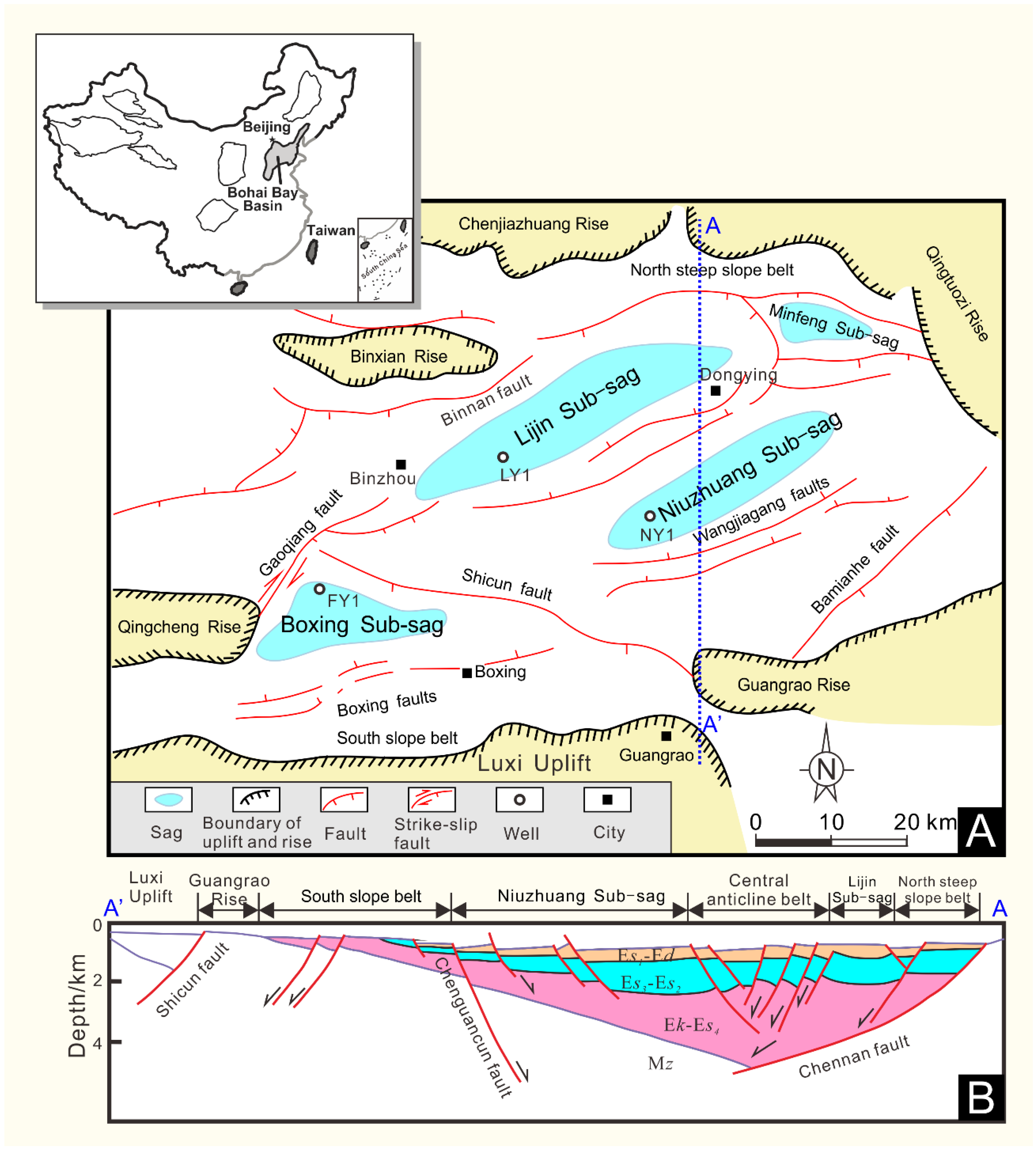
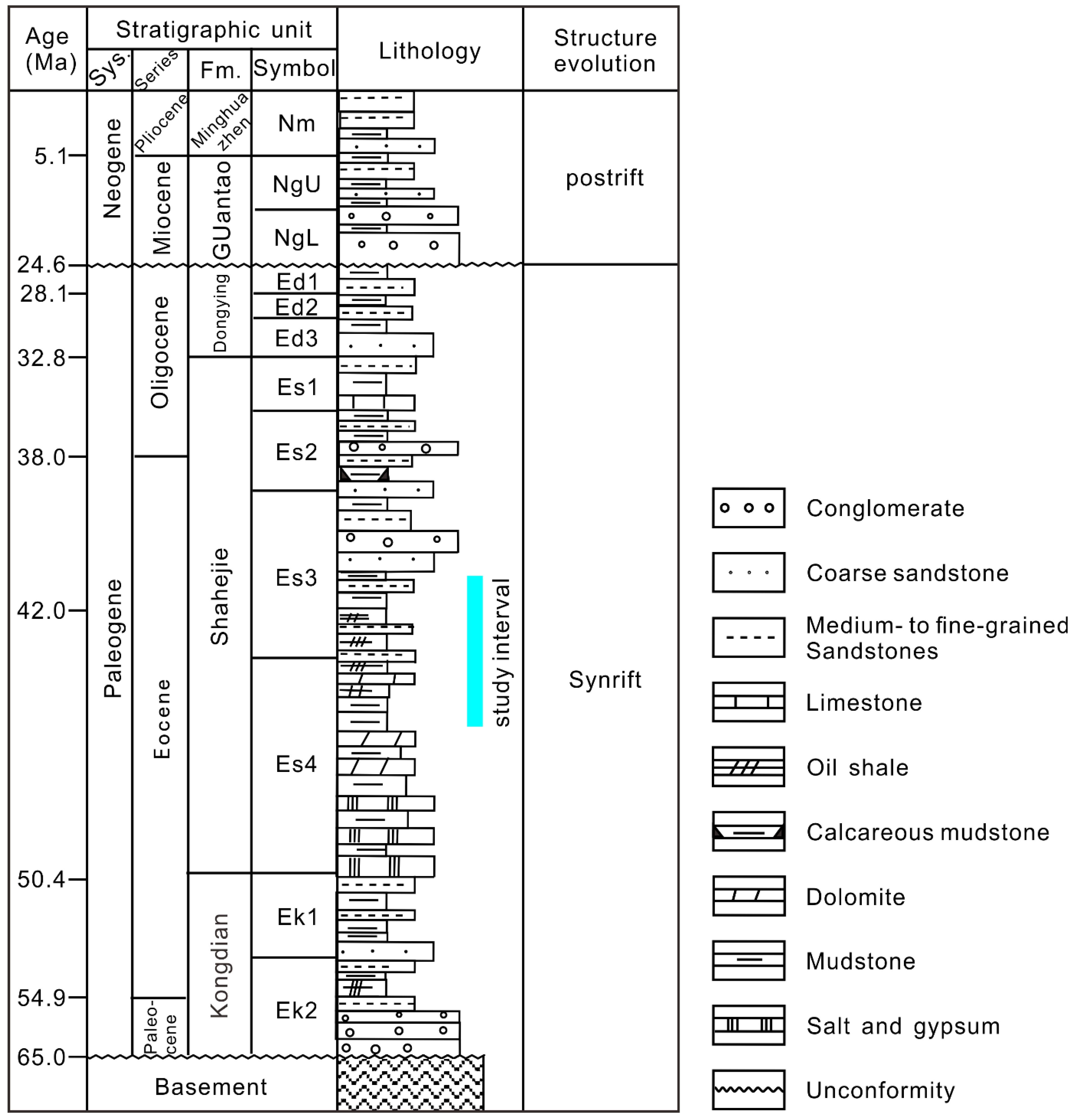
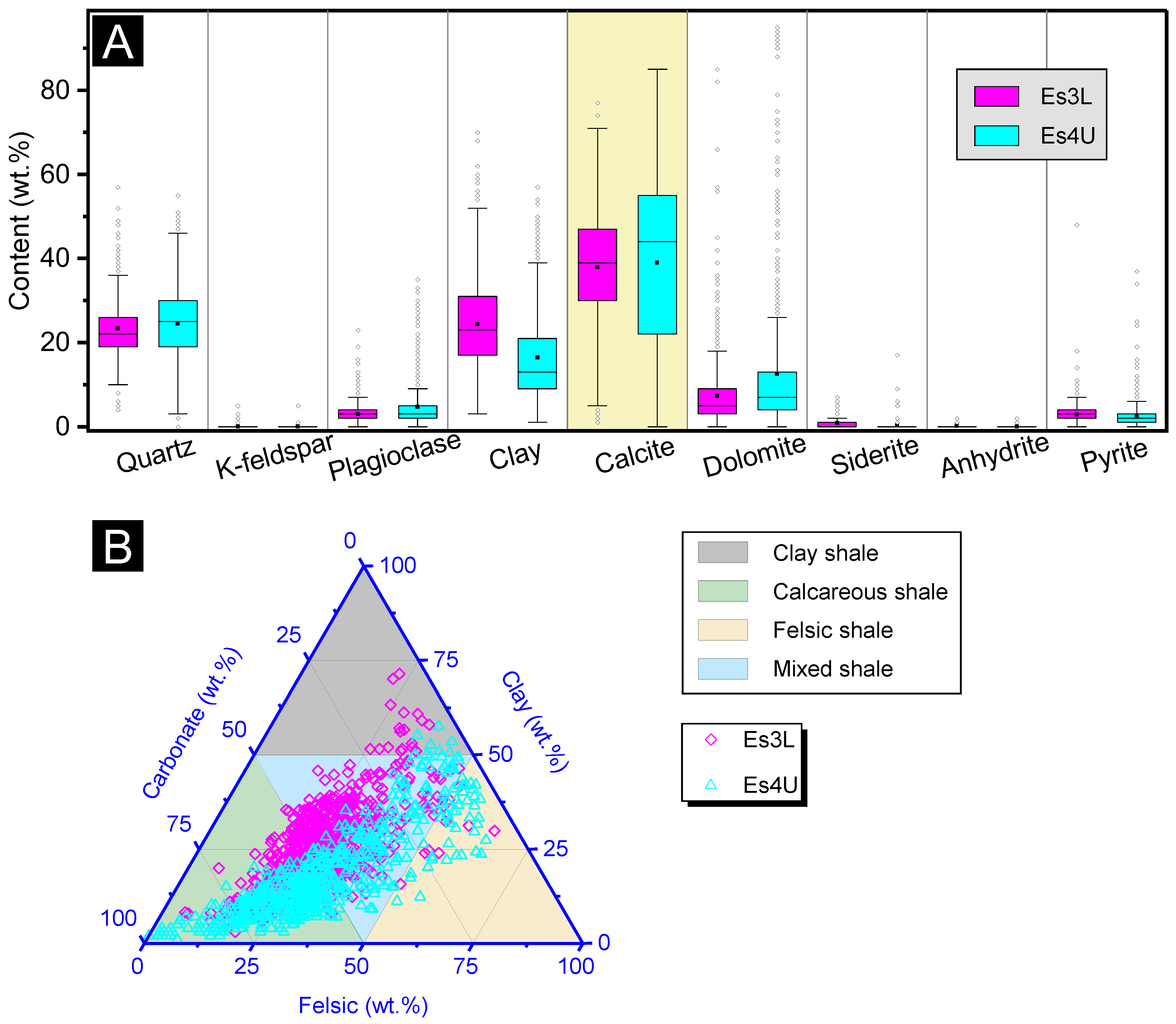


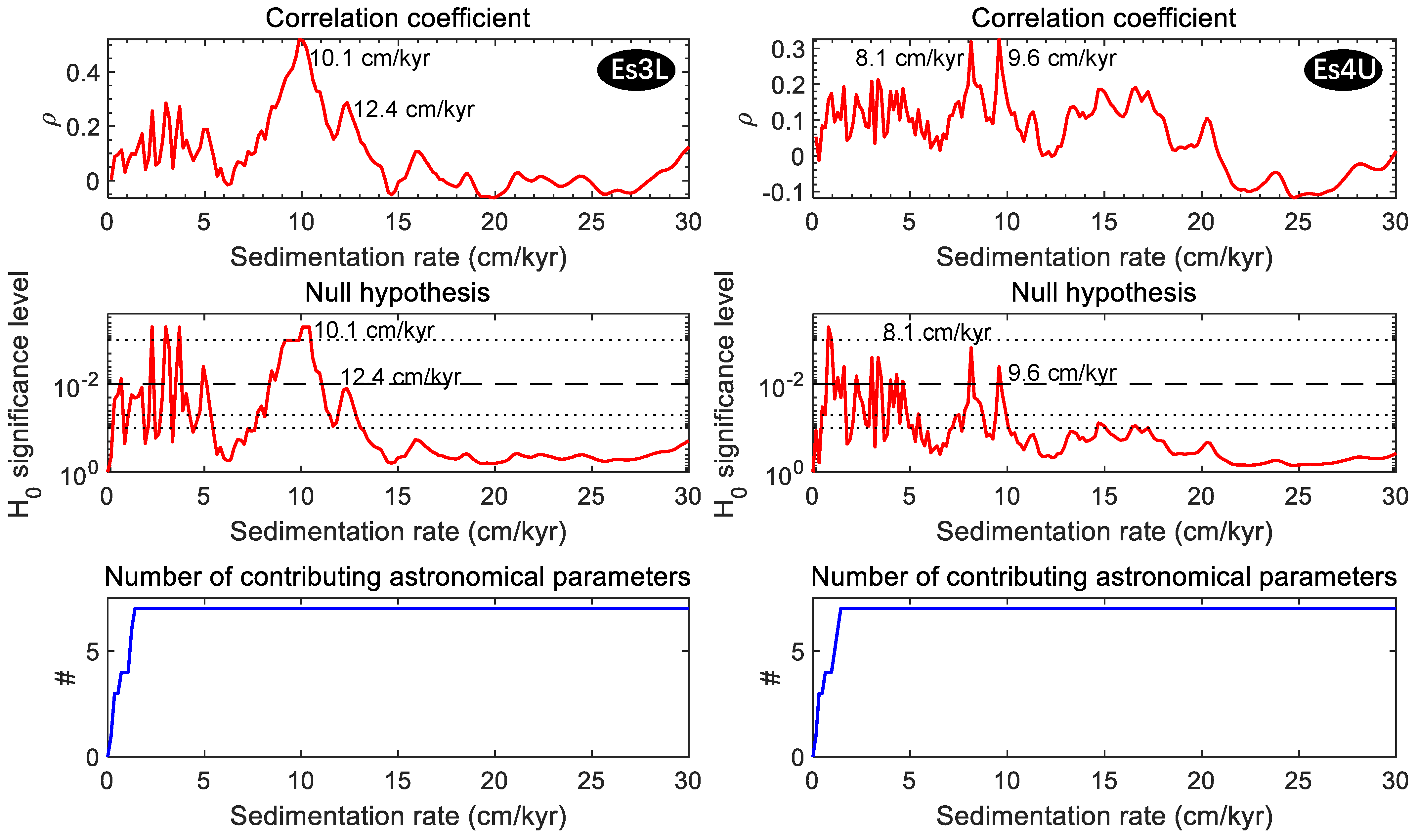
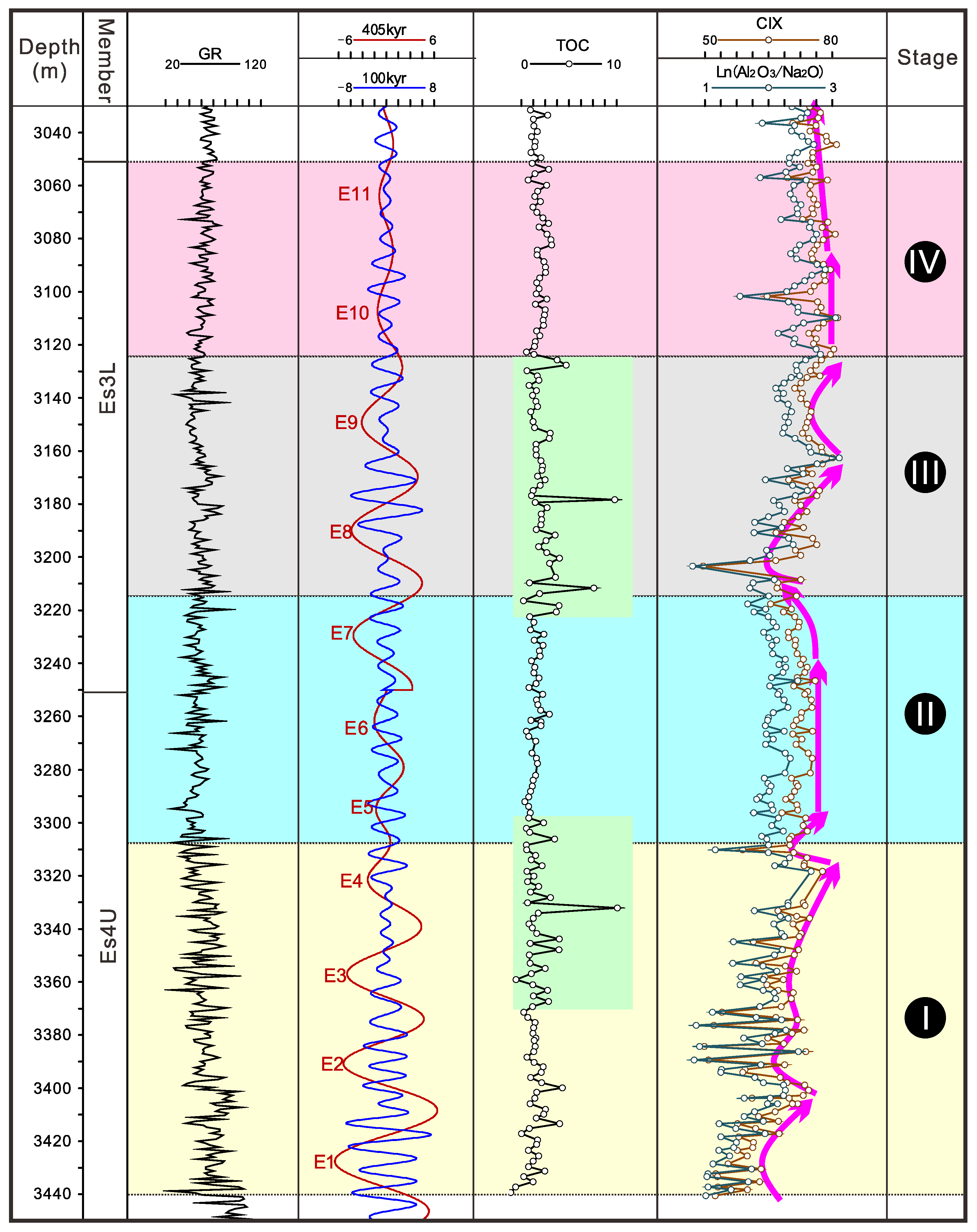
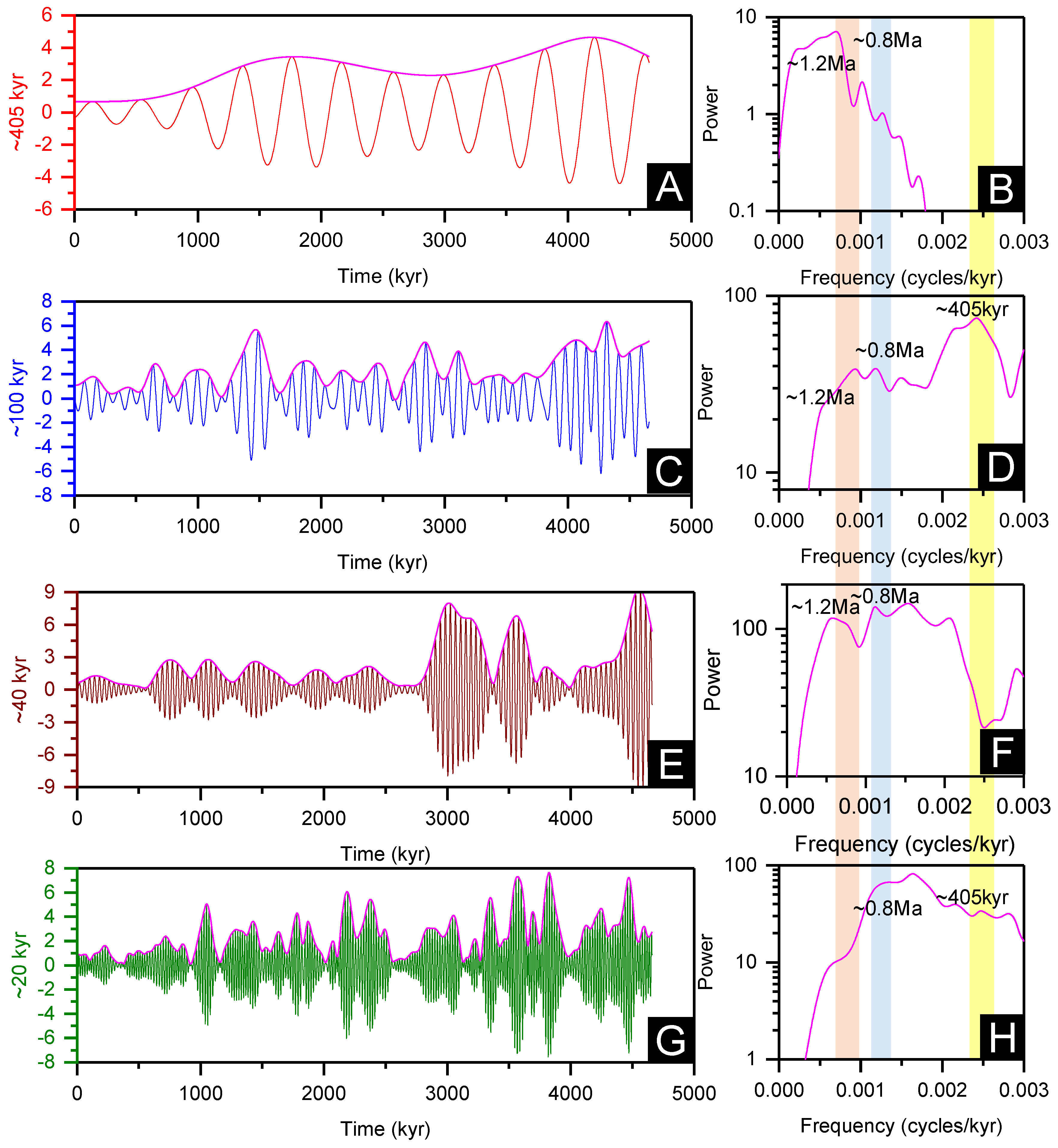
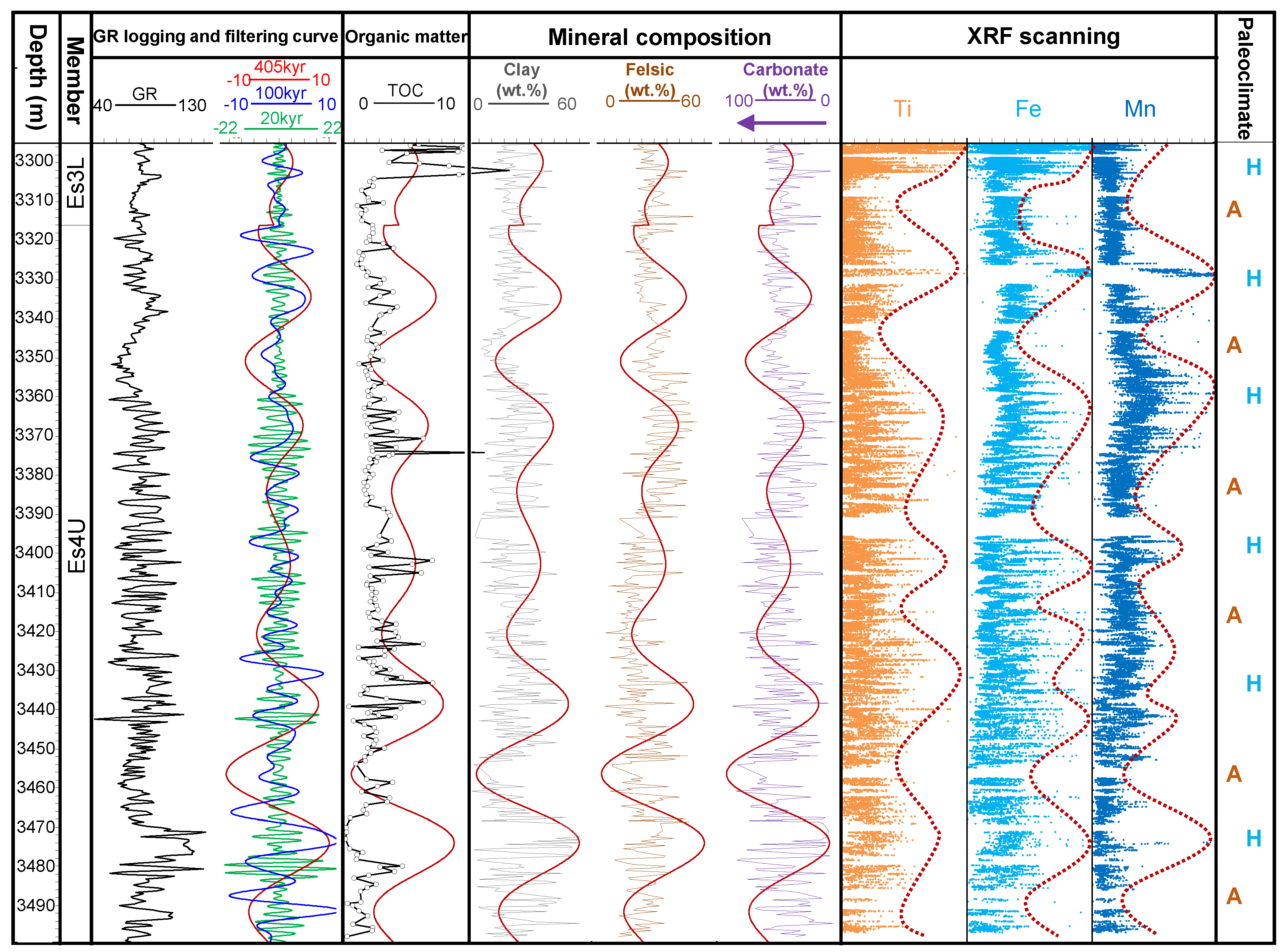

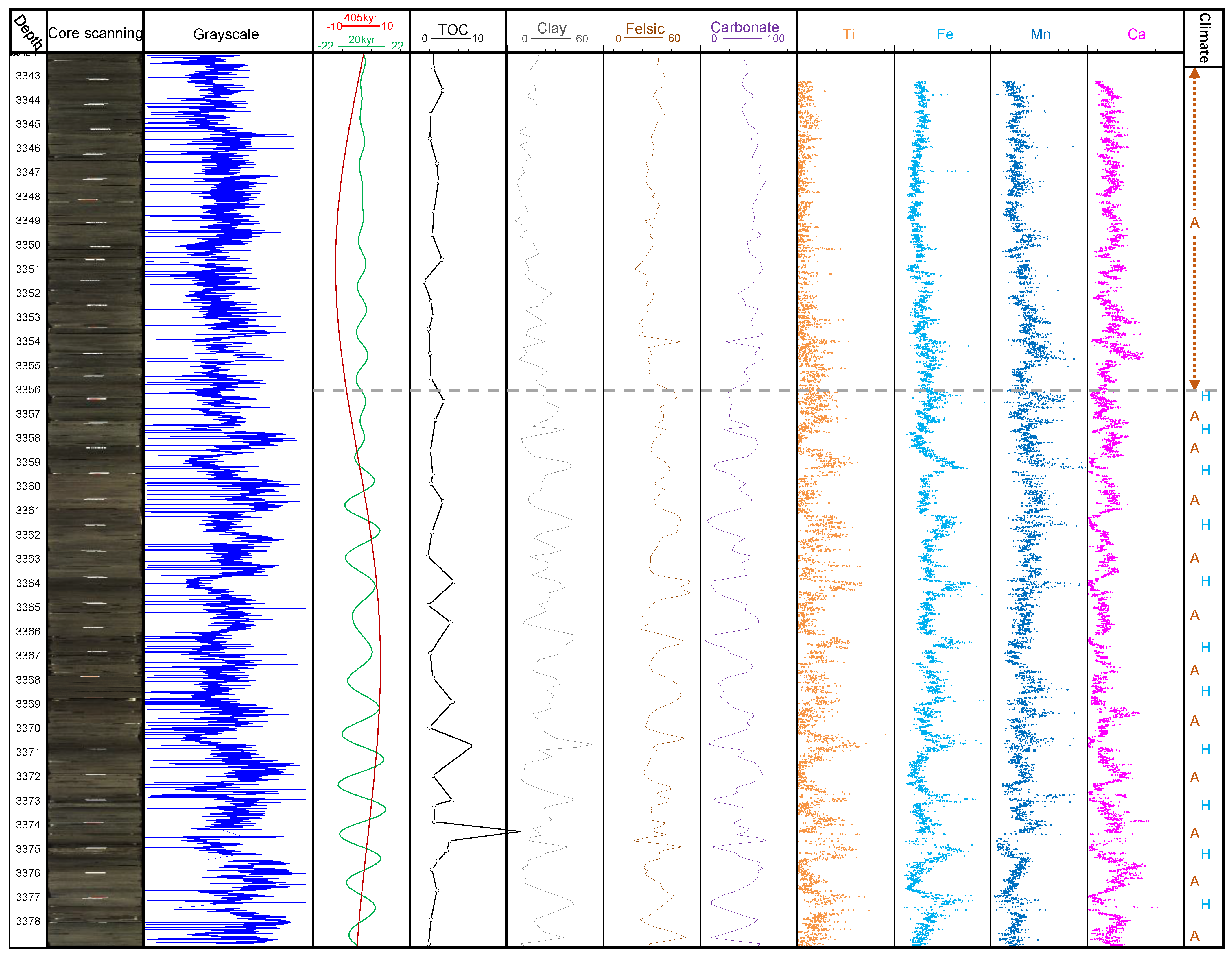
Disclaimer/Publisher’s Note: The statements, opinions and data contained in all publications are solely those of the individual author(s) and contributor(s) and not of MDPI and/or the editor(s). MDPI and/or the editor(s) disclaim responsibility for any injury to people or property resulting from any ideas, methods, instructions or products referred to in the content. |
© 2023 by the authors. Licensee MDPI, Basel, Switzerland. This article is an open access article distributed under the terms and conditions of the Creative Commons Attribution (CC BY) license (https://creativecommons.org/licenses/by/4.0/).
Share and Cite
Li, Q.; Xu, S.; Li, J.; Guo, R.; Wang, G.; Wang, Y. Effects of Astronomical Cycles on Laminated Shales of the Paleogene Shahejie Formation in the Dongying Sag, Bohai Bay Basin, China. Energies 2023, 16, 3624. https://doi.org/10.3390/en16093624
Li Q, Xu S, Li J, Guo R, Wang G, Wang Y. Effects of Astronomical Cycles on Laminated Shales of the Paleogene Shahejie Formation in the Dongying Sag, Bohai Bay Basin, China. Energies. 2023; 16(9):3624. https://doi.org/10.3390/en16093624
Chicago/Turabian StyleLi, Qiqi, Shang Xu, Junliang Li, Ruichao Guo, Guangwei Wang, and Yufan Wang. 2023. "Effects of Astronomical Cycles on Laminated Shales of the Paleogene Shahejie Formation in the Dongying Sag, Bohai Bay Basin, China" Energies 16, no. 9: 3624. https://doi.org/10.3390/en16093624
APA StyleLi, Q., Xu, S., Li, J., Guo, R., Wang, G., & Wang, Y. (2023). Effects of Astronomical Cycles on Laminated Shales of the Paleogene Shahejie Formation in the Dongying Sag, Bohai Bay Basin, China. Energies, 16(9), 3624. https://doi.org/10.3390/en16093624







